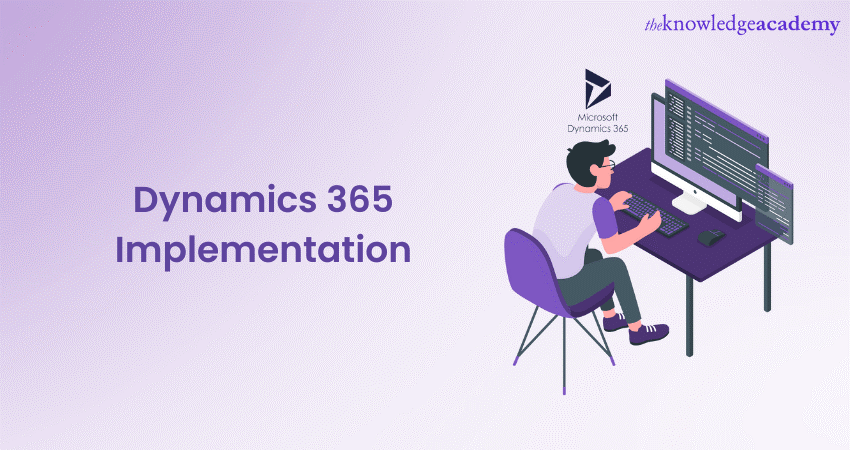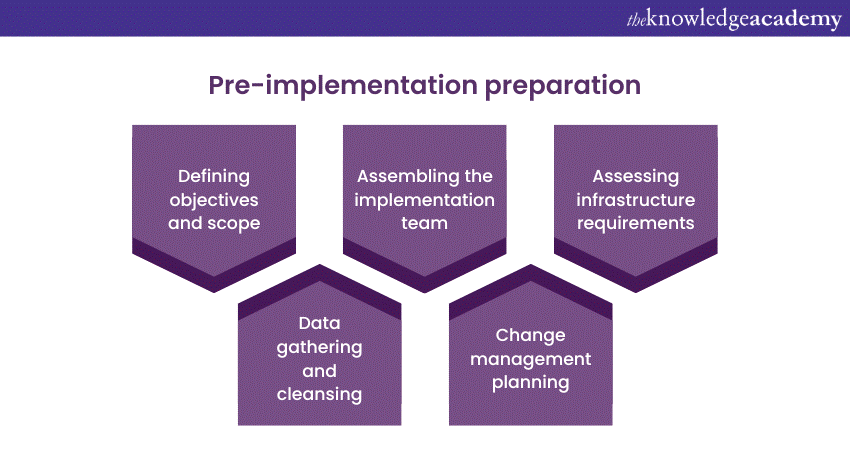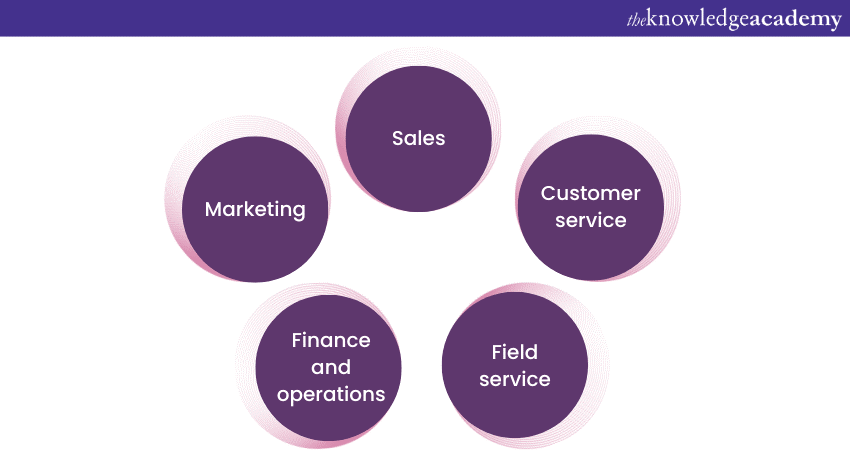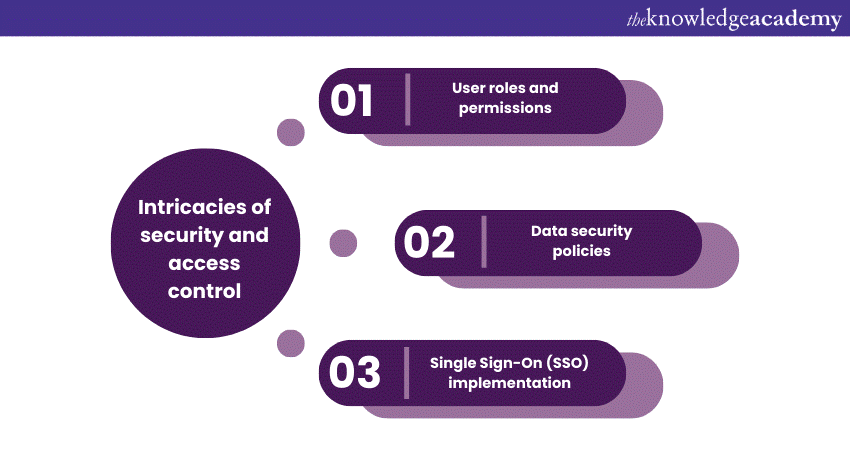We may not have the course you’re looking for. If you enquire or give us a call on +44 1344 203 999 and speak to our training experts, we may still be able to help with your training requirements.
We ensure quality, budget-alignment, and timely delivery by our expert instructors.

Undertaking the Microsoft Dynamics 365 Implementation journey is transformative work. This blog explores the intricacies of planning, customisation, integration, and user adoption. From selecting suitable applications to ensuring data security, this handbook equips you with insights and strategies for a successful Implementation.
The information provided in this blog will help you get the Dynamics 365 Implementation successfully and meet your business objectives. Read below to learn more!
Table of Contents
1) Introduction to Dynamics 365
2) Pre-implementation preparation
3) Select the right Dynamics 365 applications
4) Customisation and configuration
5) Integration with existing systems
6) Security and access control
7) Testing and quality assurance
8) Training and change management
9) Conclusion
Introduction to Dynamics 365
Enter Microsoft Dynamics 365—an integrated suite of cloud-based business applications that combines the power of Customer Relationship Management (CRM) and enterprise resource planning functionalities. Developed to cater to organisations, Dynamics 365 offers a versatile platform that empowers businesses to optimise processes, enhance customer experiences, and drive growth.
At its core, Dynamics 365 is not just another software solution; it is a comprehensive ecosystem that unifies critical aspects of an enterprise. This suite encompasses various applications, each tailored to address specific business needs. From managing sales pipelines, customer inquiries, and service requests to optimising financial operations, supply chains, and marketing efforts, Dynamics 365 covers the entire spectrum of business functions.
What sets Dynamics 365 apart is its cloud-first approach. By harnessing the power of the cloud, organisations can enjoy unparalleled scalability, flexibility, and accessibility. This cloud-based architecture eradicates the need for hefty on-premises installations, enabling businesses to deploy and scale applications based on evolving requirements rapidly. The result is an agile and adaptable environment that maintains pace with the ever-evolving needs of the modern business landscape.
Moreover, Dynamics 365 capitalises on advanced analytics and Artificial Intelligence (AI) capabilities, enabling businesses to unlock insights from their data and make informed decisions. Whether predicting customer behaviours, identifying trends, or automating routine tasks, these built-in intelligent features empower organisations to operate with a competitive edge.
In essence, Dynamics 365 is a strategic enabler for digital transformation. It simplifies complex processes, fosters collaboration across departments, breaks down data silos, and offers a 360-degree view of customer interactions. As businesses evolve in a technology-driven era, embracing Dynamics 365 is not just a choice—it is a strategic imperative that empowers organisations to stay agile, relevant, and customer-centric.
Ready to unlock the full potential of Dynamics 365? Explore our comprehensive Microsoft Dynamics 365 Training and elevate your skills!
Pre-implementation preparation
Every successful Microsoft Dynamics 365 Implementation begins with a clear sense of the goals and results desired. Organisations should identify pain points, areas of improvement, and specific business processes to enhance itself.

By setting realistic objectives and defining the scope of the implementation, the entire team gains a unified vision of what needs to be achieved, ensuring alignment throughout the process.
a) Multidisciplinary team: An effective Microsoft Dynamics 365 Implementation requires a multidisciplinary team that brings together individuals with diverse skills and expertise. This team typically includes representatives from different departments, such as IT, operations, sales, marketing, and customer service. By involving stakeholders early on, organisations can guarantee that all viewpoints are considered, leading to a solution that caters to the needs of various business functions.
b) Technological infrastructure: A crucial aspect of pre-implementation planning involves assessing the technological infrastructure necessary to support Dynamics 365. This includes evaluating hardware, network capabilities, and compatibility with existing systems. Organisations must determine whether to opt for cloud-based deployment or on-premises solutions, considering factors such as scalability, security, and accessibility.
c) Data preparation: Clean and accurate data is the lifeblood of any successful CRM and ERP implementation. Before migrating data to Dynamics 365, organisations must thoroughly audit their existing data sources, identify redundancies, inconsistencies, and data gaps, and cleanse the data to ensure its integrity. This step is vital to prevent inaccuracies and ensure the new system starts on a solid foundation.
Implementing Dynamics 365 often changes processes, workflows, and user interactions. Preparing for these changes is essential to facilitate user adoption and minimise resistance. A change management plan outlines how the organisation will communicate changes to employees, provide training and support, and manage potential challenges during the transition.
Ace your interview with our expert guide on "Dynamic 365 Interview Questions and Answers"! Get key insights and boost your confidence. Click here to start preparing today!
Select the right Dynamics 365 applications
The Dynamics 365 Sales application is a cornerstone for organisations aiming to enhance their sales processes. It empowers sales teams with tools to efficiently manage leads, opportunities, and customer interactions. From tracking customer interactions to forecasting and pipeline management, Dynamics 365 Sales provides insights that enable sales representatives to close deals more effectively.

a) Dynamics 365 Customer Service: For organisations prioritising exceptional customer experiences, Dynamics 365 Customer Service is the answer. This application efficiently manages customer inquiries, service requests, and case resolution. With features like knowledge base integration and multi-channel support, it equips customer service teams to provide timely and personalised assistance.
b) Dynamics 365 Field Service: This is ideal for businesses with field operations as Dynamics 365 Field Service streamlines scheduling, dispatching, and resource management. It empowers field technicians with real-time insights, enabling them to optimise service delivery, reduce downtime, and enhance customer satisfaction through efficient issue resolution.
c) Dynamics 365 Finance and Operations: It delivers a complete explanation for managing financial processes, supply chains, and manufacturing operations. It facilitates accurate financial reporting, inventory management, demand forecasting, and more. This application mainly benefits organisations seeking to streamline complex financial and operational tasks.
Unlock your potential in Dynamics 365 CRM! Find your dream job and lead the way in customer engagement today!
d) Dynamics 365 Marketing: Dynamics 365 Marketing enables targeted and personalised marketing campaigns. From lead generation and nurturing to measuring campaign effectiveness, this application equips marketing teams with the tools to engage customers effectively and drive conversions.
e) Dynamics 365 Supply Chain Management: It is paramount for institutions focused on timely deliveries and optimal inventory levels. Dynamics 365 Supply Chain Management offers end-to-end visibility, demand forecasting, and inventory optimisation capabilities to ensure smooth operations.
While Dynamics 365 applications cater to specific needs, organisations often require customisations or integrations to align with their unique processes. Customisation allows tailoring the applications to specific workflows, while integration ensures seamless data flow between Dynamics 365 and other business systems.
Streamline your operations and boost productivity with Dynamics 365 Business Central – the ultimate tool for business success!
Customisation and configuration
Customisation involves adapting Dynamics 365 applications to match an organisation's specific workflows, terminologies, and business rules. This ensures that the software becomes an integrated part of daily operations rather than a detached tool. Customisations can include modifying data fields, creating new entities to store unique data, and configuring views and forms to present information relevant to users' roles.
a) Customisation: Creating custom entities and fields becomes invaluable when Dynamics 365's built-in entities do not align with your organisation's needs. These customisations allow you to capture specialised data and relationships central to your operations. For instance, you can create a custom entity to track unique product attributes or customer interactions specific to your industry.
b) Automation: Automation is a cornerstone of efficiency. Dynamics 365 empowers organisations to create workflows and business rules that automate routine processes and enforce business logic. Workflows guide users through step-by-step processes, such as lead qualification or approval workflows, ensuring consistency and adherence to established procedures.
c) User Interface (UI): A user-friendly interface enhances user adoption and productivity. Dynamics 365 offers tools to modify the User Interface (UI) to present information in a way that resonates with users. This includes rearranging fields, adding quick actions, and personalising dashboards to align with individual roles and responsibilities.
d) Decision-making: Insights derived from data are pivotal for informed decision-making. Custom reports and dashboards allow organisations to visualise data according to their requirements. Dynamics 365 provides tools to create tailored messages and dashboards that deliver insights into sales performance, customer trends, and operational metrics.
Integration with existing systems
a) Data consolidation: Integrating Dynamics 365 with Customer Relationship Management (CRM) and Enterprise Resource Planning (ERP) systems consolidates customer and operational data. This synergy provides a holistic view of customer interactions, financial transactions, and inventory levels, enabling informed decisions that drive customer satisfaction and operational excellence.
b) Data migration: Moving existing data into Dynamics 365 necessitates a robust migration strategy. Accurate and complete data migration is essential to maintain data integrity and enable a smooth transition. Organisations must map data structures, cleanse and transform data, and execute migration tests to ensure a seamless transfer.
c) Third-party application integration: Most organisations rely on a myriad of software applications for diverse purposes. Integrating Dynamics 365 with these third-party applications—such as marketing automation tools, e-commerce platforms, or analytics software—fosters a cohesive ecosystem that eliminates manual data transfer and enhances productivity.
d) Application Programming Interfaces (APIs): APIs and middleware act as bridges between systems, facilitating data exchange and communication and utilising APIs and middleware streamlines integration processes by enabling seamless data transfer, synchronisation, and automation across systems.
Security and access control
a) Role-based security model: Dynamics 365 provides a role-based security model that defines user roles and their associated permissions. Organisations can tailor user access according to job roles, providing users access to the data and functionalities essential for their tasks. This granularity minimises the risk of unauthorised data exposure.

a) Data security policies: Sensitive data requires an extra layer of protection. Dynamics 365 allows organisations to implement data security policies, specifying rules for who can access specific records based on criteria such as ownership, department, or geographical location. This ensures that sensitive customer or financial data remains accessible only to authorised individuals.
b) Single Sign-on (SSO): Streamlining user access while maintaining security is a delicate balance. SSO implementation allows users to access Dynamics 365 using their existing credentials, reducing the need for multiple login credentials. This convenience enhances User Experience (UX) while maintaining security through centralised authentication protocols.
c) Auditing: Visibility into user actions and system activities is crucial for maintaining security and compliance. Dynamics 365 offers auditing and monitoring features that track record changes, user logins, and system activities. This audit trail not only aids in identifying security breaches but also serves regulatory compliance needs.
Security, however, extends beyond technological measures. User learning and awareness play a crucial role in preventing security breaches. Organisations should conduct regular training sessions to educate users regarding best practices.
Testing and quality assurance
a) Unit testing: It involves scrutinising individual components and configurations within Dynamics 365. It ensures that customisations, workflows, and business rules function as intended. By identifying and rectifying issues at this granular level, organisations lay the groundwork for a stable implementation.
b) User Acceptance Testing (UAT): It involves engaging end-users to validate the system's functionality against real-world scenarios. UAT assesses whether the Dynamics 365 solution meets user requirements and aligns with business processes. This phase often uncovers usability issues, allowing organisations to fine-tune the design based on user feedback.
c) Performance testing: Dynamics 365's performance under varying conditions is a critical consideration. Performance testing assesses how the system handles heavy user loads, complex workflows, and large datasets. Organisations can identify potential bottlenecks and ensure the system's responsiveness by simulating real-world usage scenarios.
d) Regression testing: It changes introduced during customisations, updates, or integrations can inadvertently affect existing functionalities. Regression testing ensures that modifications do not disrupt previously functioning aspects of the system. It safeguards against unintended consequences and maintains the system's overall stability.
e) Support system: Quality assurance extends beyond the testing phases. Documentation is vital, ensuring that configurations, customisations, and test cases are well-documented for reference and future maintenance. Additionally, having a dedicated support system to address post-implementation issues and user queries further reinforces the quality of the deployed solution.
Looking to build a solid foundation in Microsoft Dynamics 365? Dive into our Introduction To Microsoft Dynamics 365 55250A Training now!
Training and change management
Tailored training programs: Equipping users with the knowledge and skills to navigate and utilise Dynamics 365 is essential. End-user training programs should be tailored to various organisational roles, focusing on how the system enhances specific job functions. These training sessions can be delivered through workshops, webinars, or self-paced modules to accommodate different learning preferences.
a) Change adoption strategies: Transitioning to a new system often requires more support from users accustomed to familiar processes. Change adoption strategies involve communication campaigns that highlight the benefits of Dynamics 365, address concerns, and provide reassurance. Regular updates about the implementation's progress and its positive impact on individuals and the organisation help create a sense of ownership and enthusiasm for the change.
b) Post-implementation support: The post-implementation phase is a critical period where users may encounter challenges while adapting to the new system. Offering dedicated user support through help desks, online resources, and knowledgeable personnel ensures users have a safety net when navigating uncertainties or issues.
c) Resistance to change: Change is met with differing phases of opposition. Identifying and addressing sources of resistance early on is essential. By involving key stakeholders, addressing concerns, and offering incentives for embracing the change, organisations can minimise resistance and create an environment conducive to adoption.
Go-live and post-implementation support
a) Deployment strategy: Choosing the right deployment strategy—a comprehensive "big bang" approach, phased rollout, or parallel implementation—depends on the organisation's size, complexity, and readiness. Each strategy has its merits, balancing risk and benefits, and organisations must determine the most suitable approach.
b) Vigilance: Vigilance during the go-live phase is crucial. Real-time monitoring of system performance, user interactions, and unforeseen issues is essential. A designated go-live support team ready to address glitches ensures a swift response and minimises disruptions.
c) Post-implementation: Even with meticulous planning, post-implementation issues may arise. These issues could range from minor glitches to user queries. A well-defined process to log, prioritise, and resolve these issues ensures that the solution remains stable and user satisfaction is maintained.
Post-implementation is an opportunity for iterative enhancement. Regularly gathering user feedback, tracking performance metrics, and identifying areas for improvement allows organisations to refine the Dynamics 365 solution over time. This iterative process ensures that the solution remains aligned with evolving business needs.
Conclusion
Microsoft Dynamics 365 is a business application platform with a wide range of features, encompassing enterprise CRM, ERP, analytical tools, and productivity resources. It enables the development of customised applications with minimal coding requirements. As organisations steer the path, the Microsoft Dynamics 365 Implementation remains essential with insights and strategies to maximise the potential.
Improve operational efficiency with our Microsoft Dynamics 365 Training!
Frequently Asked Questions
What are the Other Resources and Offers Provided by The Knowledge Academy?

The Knowledge Academy takes global learning to new heights, offering over 3,000 online courses across 490+ locations in 190+ countries. This expansive reach ensures accessibility and convenience for learners worldwide.
Alongside our diverse Online Course Catalogue, encompassing 19 major categories, we go the extra mile by providing a plethora of free educational Online Resources like News updates, Blogs, videos, webinars, and interview questions. Tailoring learning experiences further, professionals can maximise value with customisable Course Bundles of TKA.
Upcoming Office Applications Resources Batches & Dates
Date
 Retired : Microsoft Dynamics 365 Sales MB210
Retired : Microsoft Dynamics 365 Sales MB210
Fri 21st Mar 2025
Fri 2nd May 2025
Fri 29th Aug 2025
Fri 3rd Oct 2025
Fri 5th Dec 2025






 Top Rated Course
Top Rated Course



 If you wish to make any changes to your course, please
If you wish to make any changes to your course, please


